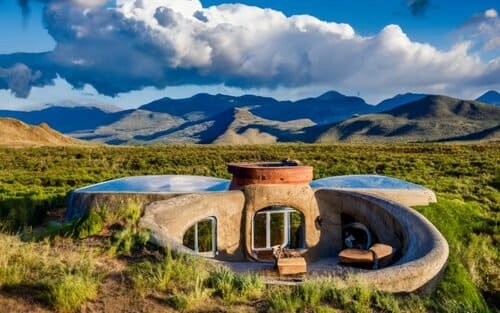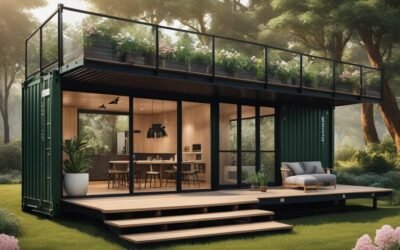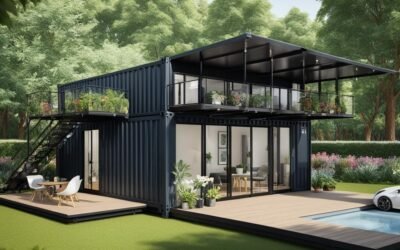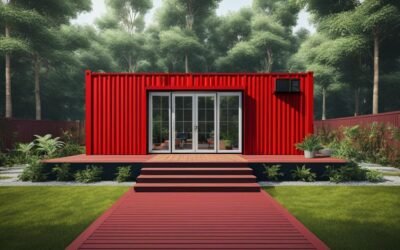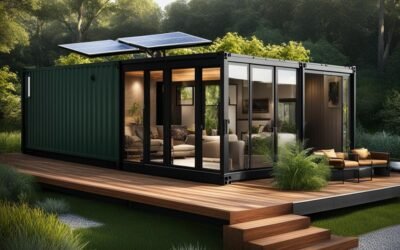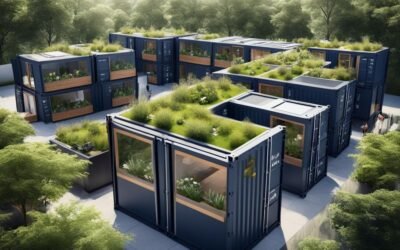Are you interested in buying a shipping container but not sure how much they cost or where to start? Look no further! In this buying guide, I’ll walk you through all the essential information you need to know about shipping container prices and help you make an informed decision. Whether you’re purchasing a container for personal use or business purposes, understanding the factors that affect the cost and choosing the right container size and condition is key to a successful purchase.
Key Takeaways:
- Shipping container prices vary based on factors such as size, condition, and location.
- Standard shipping containers and high cube containers are common options, with sizes ranging from 10 to 45 feet.
- The cost of a container can range from a few thousand dollars to several thousand dollars.
- New containers are more expensive but offer excellent condition, while used containers can provide cost savings.
- Consider your specific needs, location, and transportation requirements when deciding to buy or rent a shipping container.
Types of Shipping Containers
When buying a shipping container, it’s important to understand the different types available. The two main types are standard shipping containers and high cube shipping containers. Let’s take a closer look at each:
Standard Shipping Containers
Standard shipping containers come in various lengths, including 10, 20, 40, and 45 feet. These containers have a height of 8 feet 6 inches and are suitable for most storage needs. Whether you need to transport goods or store items, standard shipping containers provide a reliable and cost-effective solution.
High Cube Shipping Containers
If you have larger or specialty cargo that requires extra space, high cube shipping containers are a great option. These containers offer an additional foot of height compared to standard containers, providing more vertical space for your goods. High cube containers are particularly beneficial when transporting or storing tall items.
Aside from standard and high cube containers, there are also specialty containers available to meet specific needs. For example, container offices are highly popular in the construction industry, offering a convenient and customizable workspace solution. These specialty containers can be modified to cater to your unique requirements.
As you can see, there are various types of shipping containers to choose from, depending on your specific needs. Consider the size, height, and purpose of your cargo when making a decision. The right container can ensure the safe transportation or storage of your items.
Choosing the Right Size and Condition
 When buying a shipping container, it’s crucial to select the appropriate size and condition that align with your specific requirements. The most commonly available sizes are 20 and 40 feet in length, with a 20-foot container being equivalent to a one-car garage and a 40-foot container providing a space equivalent to a two-car garage in terms of length. Choosing the right size container ensures that you have adequate storage volume for your needs.
When buying a shipping container, it’s crucial to select the appropriate size and condition that align with your specific requirements. The most commonly available sizes are 20 and 40 feet in length, with a 20-foot container being equivalent to a one-car garage and a 40-foot container providing a space equivalent to a two-car garage in terms of length. Choosing the right size container ensures that you have adequate storage volume for your needs.
Here is an overview of the cost range for these standard sizes:
| Container Size | Cost Range |
|---|---|
| 20 feet | $1,100 – $5,000 |
| 40 feet | $1,350 – $9,800 |
In addition to size, considering the condition of the container is essential. You have two primary options: new containers and used containers.
New containers, also known as one-trip containers, are in excellent shape as they have been used for shipping cargo only once. They exhibit minimal signs of wear and tear, providing you with a container that is almost brand new.
Used containers may have minor dings, dents, and surface rust due to their previous use in overseas freight. However, they still offer a cost-effective solution for storage purposes. Used containers can be classified into two categories:
- Cargo worthy containers: These containers meet the necessary structural integrity requirements for shipping purposes. They are suitable for secure storage and can be used to transport cargo internationally.
- Wind & watertight containers: While not suitable for international shipping, these containers provide a sealed storage option, protecting your goods from the elements.
It’s important to note that there are also as-is containers available, which are typically in rough condition and may require repairs before they can be used effectively.
By carefully considering the size and condition of the shipping container, you can ensure you choose the right container that meets your needs while staying within your budget.
Buying vs. Renting – When Should You Buy Shipping Containers?
 Deciding whether to buy or rent a shipping container depends on several factors. If you need a container for a year or longer, buying is usually more cost-effective than renting. However, if you only need extra storage for seasonal use or temporary projects, renting may be a better option.
Deciding whether to buy or rent a shipping container depends on several factors. If you need a container for a year or longer, buying is usually more cost-effective than renting. However, if you only need extra storage for seasonal use or temporary projects, renting may be a better option.
Ownership of a container allows for modifications and customization, while rented containers generally need to remain in the same location. If you need to store hazardous materials, buying a container provides more flexibility compared to rented containers, which may have restrictions.
Additionally, consider your ability to transport the container if you decide to buy one. If moving the container frequently is challenging, renting may be a more convenient choice, with the option to have containers delivered directly to the worksite.
Key Considerations:
- If you need long-term storage or a permanent structure, buying is usually more cost-effective.
- If you only require temporary storage or seasonal use, renting can be a practical choice.
- Buying allows for modifications and customization, while rented containers may have restrictions on alterations.
- If you need to move the container frequently, renting provides convenience with direct delivery options.
“Owning a shipping container gives you more control and flexibility over its use, allowing for modifications and customization to meet specific needs.”
Ultimately, the decision between buying and renting a shipping container depends on your unique circumstances and requirements. Consider the duration of use, need for customization, restrictions on alterations, and transportation logistics to make the best choice.
| Type of Container | Benefits of Buying | Benefits of Renting |
|---|---|---|
| Long-Term Storage | Cost-effective in the long run | Flexible option for temporary needs |
| Customization | Opportunity to modify and customize | Restrictions on alterations |
| Transportation | No challenges with transportation | Direct delivery options |
Common Uses for Shipping and Storage Containers
 Shipping and storage containers are incredibly versatile and have become popular for various industries and purposes. Let’s explore some of the common uses for these containers:
Shipping and storage containers are incredibly versatile and have become popular for various industries and purposes. Let’s explore some of the common uses for these containers:
1. Construction
Shipping containers are often used in the construction industry as temporary offices, storage units for tools and equipment, and even as on-site accommodation for workers.
2. Manufacturing
Manufacturers utilize shipping containers for storing raw materials, finished products, and excess inventory. These containers provide secure and weather-resistant storage options.
3. Education
Shipping containers have been repurposed as portable classrooms, libraries, and even art studios. Their mobility and durability make them ideal for temporary or remote educational facilities.
4. Automotive
In the automotive industry, containers are used for vehicle storage, workshops, and even mobile service centers at events or in remote locations.
5. Retail
Shipping containers have become a popular choice for creating pop-up shops, outdoor markets, and unique retail spaces. They offer a cost-effective and customizable solution for businesses.
6. Agriculture
In the agricultural sector, containers are used to store farming equipment, produce, and animal feed. They provide a secure and weather-resistant environment for essential farming resources.
7. Healthcare
Containers are often converted into mobile medical clinics, disaster relief facilities, and even hospitals. Their mobility allows healthcare services to reach remote or emergency-affected areas more easily.
8. Residential Storage
Shipping containers are widely used for residential storage solutions. Whether for personal or business use, these containers offer a secure and cost-effective way to store belongings.
9. Innovative Structures
One of the most exciting uses for shipping containers is their conversion into innovative structures such as container homes, offices, restaurants, coffee shops, and art installations. These repurposed containers offer sleek design, efficient use of space, and environmental benefits by reusing existing resources.
The uses for shipping and storage containers are virtually limitless. Their versatility, durability, and cost-effectiveness have made them an integral part of various industries and businesses.
Conclusion
When it comes to shipping container costs, there are a few key factors to consider. The type and size of container that meets your specific needs play a significant role in determining the price. Standard shipping containers and high cube containers, available in sizes ranging from 10 to 45 feet, are popular options. The cost of a container can vary from a few thousand dollars to several thousand dollars, depending on factors such as size and condition.
While new containers come at a higher cost, used containers can offer cost savings without compromising functionality. It’s important to assess the condition of the container, keeping in mind that minor wear and tear is expected with used containers. Location, customization options, and transportation should also be considered when making a decision.
To ensure you make an informed choice, it’s crucial to understand the different types of containers available, choose the right size and condition for your specific needs, and weigh the pros and cons of buying versus renting. By doing so, you’ll be able to find the best shipping container that meets your requirements and fits your budget.
FAQ
How much do shipping containers cost?
The prices of shipping containers vary based on factors such as size, condition, and location. A 10-foot container can cost between ,000 and ,500, a 20-foot container can range from
How much do shipping containers cost?
The prices of shipping containers vary based on factors such as size, condition, and location. A 10-foot container can cost between ,000 and ,500, a 20-foot container can range from
FAQ
How much do shipping containers cost?
The prices of shipping containers vary based on factors such as size, condition, and location. A 10-foot container can cost between ,000 and ,500, a 20-foot container can range from
FAQ
How much do shipping containers cost?
The prices of shipping containers vary based on factors such as size, condition, and location. A 10-foot container can cost between $3,000 and $4,500, a 20-foot container can range from $1,100 to $5,000, and a 40-foot container can cost anywhere between $1,350 and $9,800.
What types of shipping containers are available?
The two main types of shipping containers are standard shipping containers and high cube shipping containers. Standard containers come in sizes of 10, 20, 40, and 45 feet, while high cube containers offer an extra foot of height.
How do I choose the right size and condition of a shipping container?
When choosing a shipping container, consider your specific needs and the available sizes. The most common sizes are 20 and 40 feet. For the condition, you can choose between new containers, which are in excellent shape but more expensive, and used containers, which may have minor wear and tear but are cheaper.
Is it better to buy or rent a shipping container?
The decision to buy or rent a shipping container depends on factors like the duration of use and ownership benefits. If you need a container for a year or longer, buying is usually more cost-effective. However, for temporary or seasonal storage, renting may be a better option.
What are the common uses for shipping and storage containers?
Shipping and storage containers have a wide range of uses across various industries. They are commonly used in construction, manufacturing, retail, agriculture, and healthcare. They can also be modified into container homes, offices, restaurants, and other innovative structures.
What are the benefits of shipping container storage?
Shipping containers provide flexible and cost-effective storage solutions. They are durable, secure, and can be easily transported. They also offer environmental benefits by reusing existing resources and reducing the need for traditional construction materials.
Where can I buy shipping containers?
Shipping containers are available for sale all across the United States. You can find them from various suppliers, both online and locally. It’s important to research and compare prices, conditions, and customer reviews before making a purchase.
,100 to ,000, and a 40-foot container can cost anywhere between
FAQ
How much do shipping containers cost?
The prices of shipping containers vary based on factors such as size, condition, and location. A 10-foot container can cost between $3,000 and $4,500, a 20-foot container can range from $1,100 to $5,000, and a 40-foot container can cost anywhere between $1,350 and $9,800.
What types of shipping containers are available?
The two main types of shipping containers are standard shipping containers and high cube shipping containers. Standard containers come in sizes of 10, 20, 40, and 45 feet, while high cube containers offer an extra foot of height.
How do I choose the right size and condition of a shipping container?
When choosing a shipping container, consider your specific needs and the available sizes. The most common sizes are 20 and 40 feet. For the condition, you can choose between new containers, which are in excellent shape but more expensive, and used containers, which may have minor wear and tear but are cheaper.
Is it better to buy or rent a shipping container?
The decision to buy or rent a shipping container depends on factors like the duration of use and ownership benefits. If you need a container for a year or longer, buying is usually more cost-effective. However, for temporary or seasonal storage, renting may be a better option.
What are the common uses for shipping and storage containers?
Shipping and storage containers have a wide range of uses across various industries. They are commonly used in construction, manufacturing, retail, agriculture, and healthcare. They can also be modified into container homes, offices, restaurants, and other innovative structures.
What are the benefits of shipping container storage?
Shipping containers provide flexible and cost-effective storage solutions. They are durable, secure, and can be easily transported. They also offer environmental benefits by reusing existing resources and reducing the need for traditional construction materials.
Where can I buy shipping containers?
Shipping containers are available for sale all across the United States. You can find them from various suppliers, both online and locally. It’s important to research and compare prices, conditions, and customer reviews before making a purchase.
,350 and ,800.
What types of shipping containers are available?
The two main types of shipping containers are standard shipping containers and high cube shipping containers. Standard containers come in sizes of 10, 20, 40, and 45 feet, while high cube containers offer an extra foot of height.
How do I choose the right size and condition of a shipping container?
When choosing a shipping container, consider your specific needs and the available sizes. The most common sizes are 20 and 40 feet. For the condition, you can choose between new containers, which are in excellent shape but more expensive, and used containers, which may have minor wear and tear but are cheaper.
Is it better to buy or rent a shipping container?
The decision to buy or rent a shipping container depends on factors like the duration of use and ownership benefits. If you need a container for a year or longer, buying is usually more cost-effective. However, for temporary or seasonal storage, renting may be a better option.
What are the common uses for shipping and storage containers?
Shipping and storage containers have a wide range of uses across various industries. They are commonly used in construction, manufacturing, retail, agriculture, and healthcare. They can also be modified into container homes, offices, restaurants, and other innovative structures.
What are the benefits of shipping container storage?
Shipping containers provide flexible and cost-effective storage solutions. They are durable, secure, and can be easily transported. They also offer environmental benefits by reusing existing resources and reducing the need for traditional construction materials.
Where can I buy shipping containers?
Shipping containers are available for sale all across the United States. You can find them from various suppliers, both online and locally. It’s important to research and compare prices, conditions, and customer reviews before making a purchase.
FAQ
How much do shipping containers cost?
The prices of shipping containers vary based on factors such as size, condition, and location. A 10-foot container can cost between ,000 and ,500, a 20-foot container can range from
FAQ
How much do shipping containers cost?
The prices of shipping containers vary based on factors such as size, condition, and location. A 10-foot container can cost between $3,000 and $4,500, a 20-foot container can range from $1,100 to $5,000, and a 40-foot container can cost anywhere between $1,350 and $9,800.
What types of shipping containers are available?
The two main types of shipping containers are standard shipping containers and high cube shipping containers. Standard containers come in sizes of 10, 20, 40, and 45 feet, while high cube containers offer an extra foot of height.
How do I choose the right size and condition of a shipping container?
When choosing a shipping container, consider your specific needs and the available sizes. The most common sizes are 20 and 40 feet. For the condition, you can choose between new containers, which are in excellent shape but more expensive, and used containers, which may have minor wear and tear but are cheaper.
Is it better to buy or rent a shipping container?
The decision to buy or rent a shipping container depends on factors like the duration of use and ownership benefits. If you need a container for a year or longer, buying is usually more cost-effective. However, for temporary or seasonal storage, renting may be a better option.
What are the common uses for shipping and storage containers?
Shipping and storage containers have a wide range of uses across various industries. They are commonly used in construction, manufacturing, retail, agriculture, and healthcare. They can also be modified into container homes, offices, restaurants, and other innovative structures.
What are the benefits of shipping container storage?
Shipping containers provide flexible and cost-effective storage solutions. They are durable, secure, and can be easily transported. They also offer environmental benefits by reusing existing resources and reducing the need for traditional construction materials.
Where can I buy shipping containers?
Shipping containers are available for sale all across the United States. You can find them from various suppliers, both online and locally. It’s important to research and compare prices, conditions, and customer reviews before making a purchase.
,100 to ,000, and a 40-foot container can cost anywhere between
FAQ
How much do shipping containers cost?
The prices of shipping containers vary based on factors such as size, condition, and location. A 10-foot container can cost between $3,000 and $4,500, a 20-foot container can range from $1,100 to $5,000, and a 40-foot container can cost anywhere between $1,350 and $9,800.
What types of shipping containers are available?
The two main types of shipping containers are standard shipping containers and high cube shipping containers. Standard containers come in sizes of 10, 20, 40, and 45 feet, while high cube containers offer an extra foot of height.
How do I choose the right size and condition of a shipping container?
When choosing a shipping container, consider your specific needs and the available sizes. The most common sizes are 20 and 40 feet. For the condition, you can choose between new containers, which are in excellent shape but more expensive, and used containers, which may have minor wear and tear but are cheaper.
Is it better to buy or rent a shipping container?
The decision to buy or rent a shipping container depends on factors like the duration of use and ownership benefits. If you need a container for a year or longer, buying is usually more cost-effective. However, for temporary or seasonal storage, renting may be a better option.
What are the common uses for shipping and storage containers?
Shipping and storage containers have a wide range of uses across various industries. They are commonly used in construction, manufacturing, retail, agriculture, and healthcare. They can also be modified into container homes, offices, restaurants, and other innovative structures.
What are the benefits of shipping container storage?
Shipping containers provide flexible and cost-effective storage solutions. They are durable, secure, and can be easily transported. They also offer environmental benefits by reusing existing resources and reducing the need for traditional construction materials.
Where can I buy shipping containers?
Shipping containers are available for sale all across the United States. You can find them from various suppliers, both online and locally. It’s important to research and compare prices, conditions, and customer reviews before making a purchase.
,350 and ,800.
What types of shipping containers are available?
The two main types of shipping containers are standard shipping containers and high cube shipping containers. Standard containers come in sizes of 10, 20, 40, and 45 feet, while high cube containers offer an extra foot of height.
How do I choose the right size and condition of a shipping container?
When choosing a shipping container, consider your specific needs and the available sizes. The most common sizes are 20 and 40 feet. For the condition, you can choose between new containers, which are in excellent shape but more expensive, and used containers, which may have minor wear and tear but are cheaper.
Is it better to buy or rent a shipping container?
The decision to buy or rent a shipping container depends on factors like the duration of use and ownership benefits. If you need a container for a year or longer, buying is usually more cost-effective. However, for temporary or seasonal storage, renting may be a better option.
What are the common uses for shipping and storage containers?
Shipping and storage containers have a wide range of uses across various industries. They are commonly used in construction, manufacturing, retail, agriculture, and healthcare. They can also be modified into container homes, offices, restaurants, and other innovative structures.
What are the benefits of shipping container storage?
Shipping containers provide flexible and cost-effective storage solutions. They are durable, secure, and can be easily transported. They also offer environmental benefits by reusing existing resources and reducing the need for traditional construction materials.
Where can I buy shipping containers?
Shipping containers are available for sale all across the United States. You can find them from various suppliers, both online and locally. It’s important to research and compare prices, conditions, and customer reviews before making a purchase.
What types of shipping containers are available?
The two main types of shipping containers are standard shipping containers and high cube shipping containers. Standard containers come in sizes of 10, 20, 40, and 45 feet, while high cube containers offer an extra foot of height.
How do I choose the right size and condition of a shipping container?
When choosing a shipping container, consider your specific needs and the available sizes. The most common sizes are 20 and 40 feet. For the condition, you can choose between new containers, which are in excellent shape but more expensive, and used containers, which may have minor wear and tear but are cheaper.
Is it better to buy or rent a shipping container?
The decision to buy or rent a shipping container depends on factors like the duration of use and ownership benefits. If you need a container for a year or longer, buying is usually more cost-effective. However, for temporary or seasonal storage, renting may be a better option.
What are the common uses for shipping and storage containers?
Shipping and storage containers have a wide range of uses across various industries. They are commonly used in construction, manufacturing, retail, agriculture, and healthcare. They can also be modified into container homes, offices, restaurants, and other innovative structures.
What are the benefits of shipping container storage?
Shipping containers provide flexible and cost-effective storage solutions. They are durable, secure, and can be easily transported. They also offer environmental benefits by reusing existing resources and reducing the need for traditional construction materials.
Where can I buy shipping containers?
Shipping containers are available for sale all across the United States. You can find them from various suppliers, both online and locally. It’s important to research and compare prices, conditions, and customer reviews before making a purchase.
,100 to ,000, and a 40-foot container can cost anywhere between
How much do shipping containers cost?
The prices of shipping containers vary based on factors such as size, condition, and location. A 10-foot container can cost between ,000 and ,500, a 20-foot container can range from
FAQ
How much do shipping containers cost?
The prices of shipping containers vary based on factors such as size, condition, and location. A 10-foot container can cost between ,000 and ,500, a 20-foot container can range from
FAQ
How much do shipping containers cost?
The prices of shipping containers vary based on factors such as size, condition, and location. A 10-foot container can cost between $3,000 and $4,500, a 20-foot container can range from $1,100 to $5,000, and a 40-foot container can cost anywhere between $1,350 and $9,800.
What types of shipping containers are available?
The two main types of shipping containers are standard shipping containers and high cube shipping containers. Standard containers come in sizes of 10, 20, 40, and 45 feet, while high cube containers offer an extra foot of height.
How do I choose the right size and condition of a shipping container?
When choosing a shipping container, consider your specific needs and the available sizes. The most common sizes are 20 and 40 feet. For the condition, you can choose between new containers, which are in excellent shape but more expensive, and used containers, which may have minor wear and tear but are cheaper.
Is it better to buy or rent a shipping container?
The decision to buy or rent a shipping container depends on factors like the duration of use and ownership benefits. If you need a container for a year or longer, buying is usually more cost-effective. However, for temporary or seasonal storage, renting may be a better option.
What are the common uses for shipping and storage containers?
Shipping and storage containers have a wide range of uses across various industries. They are commonly used in construction, manufacturing, retail, agriculture, and healthcare. They can also be modified into container homes, offices, restaurants, and other innovative structures.
What are the benefits of shipping container storage?
Shipping containers provide flexible and cost-effective storage solutions. They are durable, secure, and can be easily transported. They also offer environmental benefits by reusing existing resources and reducing the need for traditional construction materials.
Where can I buy shipping containers?
Shipping containers are available for sale all across the United States. You can find them from various suppliers, both online and locally. It’s important to research and compare prices, conditions, and customer reviews before making a purchase.
,100 to ,000, and a 40-foot container can cost anywhere between
FAQ
How much do shipping containers cost?
The prices of shipping containers vary based on factors such as size, condition, and location. A 10-foot container can cost between $3,000 and $4,500, a 20-foot container can range from $1,100 to $5,000, and a 40-foot container can cost anywhere between $1,350 and $9,800.
What types of shipping containers are available?
The two main types of shipping containers are standard shipping containers and high cube shipping containers. Standard containers come in sizes of 10, 20, 40, and 45 feet, while high cube containers offer an extra foot of height.
How do I choose the right size and condition of a shipping container?
When choosing a shipping container, consider your specific needs and the available sizes. The most common sizes are 20 and 40 feet. For the condition, you can choose between new containers, which are in excellent shape but more expensive, and used containers, which may have minor wear and tear but are cheaper.
Is it better to buy or rent a shipping container?
The decision to buy or rent a shipping container depends on factors like the duration of use and ownership benefits. If you need a container for a year or longer, buying is usually more cost-effective. However, for temporary or seasonal storage, renting may be a better option.
What are the common uses for shipping and storage containers?
Shipping and storage containers have a wide range of uses across various industries. They are commonly used in construction, manufacturing, retail, agriculture, and healthcare. They can also be modified into container homes, offices, restaurants, and other innovative structures.
What are the benefits of shipping container storage?
Shipping containers provide flexible and cost-effective storage solutions. They are durable, secure, and can be easily transported. They also offer environmental benefits by reusing existing resources and reducing the need for traditional construction materials.
Where can I buy shipping containers?
Shipping containers are available for sale all across the United States. You can find them from various suppliers, both online and locally. It’s important to research and compare prices, conditions, and customer reviews before making a purchase.
,350 and ,800.
What types of shipping containers are available?
The two main types of shipping containers are standard shipping containers and high cube shipping containers. Standard containers come in sizes of 10, 20, 40, and 45 feet, while high cube containers offer an extra foot of height.
How do I choose the right size and condition of a shipping container?
When choosing a shipping container, consider your specific needs and the available sizes. The most common sizes are 20 and 40 feet. For the condition, you can choose between new containers, which are in excellent shape but more expensive, and used containers, which may have minor wear and tear but are cheaper.
Is it better to buy or rent a shipping container?
The decision to buy or rent a shipping container depends on factors like the duration of use and ownership benefits. If you need a container for a year or longer, buying is usually more cost-effective. However, for temporary or seasonal storage, renting may be a better option.
What are the common uses for shipping and storage containers?
Shipping and storage containers have a wide range of uses across various industries. They are commonly used in construction, manufacturing, retail, agriculture, and healthcare. They can also be modified into container homes, offices, restaurants, and other innovative structures.
What are the benefits of shipping container storage?
Shipping containers provide flexible and cost-effective storage solutions. They are durable, secure, and can be easily transported. They also offer environmental benefits by reusing existing resources and reducing the need for traditional construction materials.
Where can I buy shipping containers?
Shipping containers are available for sale all across the United States. You can find them from various suppliers, both online and locally. It’s important to research and compare prices, conditions, and customer reviews before making a purchase.
FAQ
How much do shipping containers cost?
The prices of shipping containers vary based on factors such as size, condition, and location. A 10-foot container can cost between ,000 and ,500, a 20-foot container can range from
FAQ
How much do shipping containers cost?
The prices of shipping containers vary based on factors such as size, condition, and location. A 10-foot container can cost between $3,000 and $4,500, a 20-foot container can range from $1,100 to $5,000, and a 40-foot container can cost anywhere between $1,350 and $9,800.
What types of shipping containers are available?
The two main types of shipping containers are standard shipping containers and high cube shipping containers. Standard containers come in sizes of 10, 20, 40, and 45 feet, while high cube containers offer an extra foot of height.
How do I choose the right size and condition of a shipping container?
When choosing a shipping container, consider your specific needs and the available sizes. The most common sizes are 20 and 40 feet. For the condition, you can choose between new containers, which are in excellent shape but more expensive, and used containers, which may have minor wear and tear but are cheaper.
Is it better to buy or rent a shipping container?
The decision to buy or rent a shipping container depends on factors like the duration of use and ownership benefits. If you need a container for a year or longer, buying is usually more cost-effective. However, for temporary or seasonal storage, renting may be a better option.
What are the common uses for shipping and storage containers?
Shipping and storage containers have a wide range of uses across various industries. They are commonly used in construction, manufacturing, retail, agriculture, and healthcare. They can also be modified into container homes, offices, restaurants, and other innovative structures.
What are the benefits of shipping container storage?
Shipping containers provide flexible and cost-effective storage solutions. They are durable, secure, and can be easily transported. They also offer environmental benefits by reusing existing resources and reducing the need for traditional construction materials.
Where can I buy shipping containers?
Shipping containers are available for sale all across the United States. You can find them from various suppliers, both online and locally. It’s important to research and compare prices, conditions, and customer reviews before making a purchase.
,100 to ,000, and a 40-foot container can cost anywhere between
FAQ
How much do shipping containers cost?
The prices of shipping containers vary based on factors such as size, condition, and location. A 10-foot container can cost between $3,000 and $4,500, a 20-foot container can range from $1,100 to $5,000, and a 40-foot container can cost anywhere between $1,350 and $9,800.
What types of shipping containers are available?
The two main types of shipping containers are standard shipping containers and high cube shipping containers. Standard containers come in sizes of 10, 20, 40, and 45 feet, while high cube containers offer an extra foot of height.
How do I choose the right size and condition of a shipping container?
When choosing a shipping container, consider your specific needs and the available sizes. The most common sizes are 20 and 40 feet. For the condition, you can choose between new containers, which are in excellent shape but more expensive, and used containers, which may have minor wear and tear but are cheaper.
Is it better to buy or rent a shipping container?
The decision to buy or rent a shipping container depends on factors like the duration of use and ownership benefits. If you need a container for a year or longer, buying is usually more cost-effective. However, for temporary or seasonal storage, renting may be a better option.
What are the common uses for shipping and storage containers?
Shipping and storage containers have a wide range of uses across various industries. They are commonly used in construction, manufacturing, retail, agriculture, and healthcare. They can also be modified into container homes, offices, restaurants, and other innovative structures.
What are the benefits of shipping container storage?
Shipping containers provide flexible and cost-effective storage solutions. They are durable, secure, and can be easily transported. They also offer environmental benefits by reusing existing resources and reducing the need for traditional construction materials.
Where can I buy shipping containers?
Shipping containers are available for sale all across the United States. You can find them from various suppliers, both online and locally. It’s important to research and compare prices, conditions, and customer reviews before making a purchase.
,350 and ,800.
What types of shipping containers are available?
The two main types of shipping containers are standard shipping containers and high cube shipping containers. Standard containers come in sizes of 10, 20, 40, and 45 feet, while high cube containers offer an extra foot of height.
How do I choose the right size and condition of a shipping container?
When choosing a shipping container, consider your specific needs and the available sizes. The most common sizes are 20 and 40 feet. For the condition, you can choose between new containers, which are in excellent shape but more expensive, and used containers, which may have minor wear and tear but are cheaper.
Is it better to buy or rent a shipping container?
The decision to buy or rent a shipping container depends on factors like the duration of use and ownership benefits. If you need a container for a year or longer, buying is usually more cost-effective. However, for temporary or seasonal storage, renting may be a better option.
What are the common uses for shipping and storage containers?
Shipping and storage containers have a wide range of uses across various industries. They are commonly used in construction, manufacturing, retail, agriculture, and healthcare. They can also be modified into container homes, offices, restaurants, and other innovative structures.
What are the benefits of shipping container storage?
Shipping containers provide flexible and cost-effective storage solutions. They are durable, secure, and can be easily transported. They also offer environmental benefits by reusing existing resources and reducing the need for traditional construction materials.
Where can I buy shipping containers?
Shipping containers are available for sale all across the United States. You can find them from various suppliers, both online and locally. It’s important to research and compare prices, conditions, and customer reviews before making a purchase.
What types of shipping containers are available?
The two main types of shipping containers are standard shipping containers and high cube shipping containers. Standard containers come in sizes of 10, 20, 40, and 45 feet, while high cube containers offer an extra foot of height.
How do I choose the right size and condition of a shipping container?
When choosing a shipping container, consider your specific needs and the available sizes. The most common sizes are 20 and 40 feet. For the condition, you can choose between new containers, which are in excellent shape but more expensive, and used containers, which may have minor wear and tear but are cheaper.
Is it better to buy or rent a shipping container?
The decision to buy or rent a shipping container depends on factors like the duration of use and ownership benefits. If you need a container for a year or longer, buying is usually more cost-effective. However, for temporary or seasonal storage, renting may be a better option.
What are the common uses for shipping and storage containers?
Shipping and storage containers have a wide range of uses across various industries. They are commonly used in construction, manufacturing, retail, agriculture, and healthcare. They can also be modified into container homes, offices, restaurants, and other innovative structures.
What are the benefits of shipping container storage?
Shipping containers provide flexible and cost-effective storage solutions. They are durable, secure, and can be easily transported. They also offer environmental benefits by reusing existing resources and reducing the need for traditional construction materials.
Where can I buy shipping containers?
Shipping containers are available for sale all across the United States. You can find them from various suppliers, both online and locally. It’s important to research and compare prices, conditions, and customer reviews before making a purchase.
,350 and ,800.
What types of shipping containers are available?
The two main types of shipping containers are standard shipping containers and high cube shipping containers. Standard containers come in sizes of 10, 20, 40, and 45 feet, while high cube containers offer an extra foot of height.
How do I choose the right size and condition of a shipping container?
When choosing a shipping container, consider your specific needs and the available sizes. The most common sizes are 20 and 40 feet. For the condition, you can choose between new containers, which are in excellent shape but more expensive, and used containers, which may have minor wear and tear but are cheaper.
Is it better to buy or rent a shipping container?
The decision to buy or rent a shipping container depends on factors like the duration of use and ownership benefits. If you need a container for a year or longer, buying is usually more cost-effective. However, for temporary or seasonal storage, renting may be a better option.
What are the common uses for shipping and storage containers?
Shipping and storage containers have a wide range of uses across various industries. They are commonly used in construction, manufacturing, retail, agriculture, and healthcare. They can also be modified into container homes, offices, restaurants, and other innovative structures.
What are the benefits of shipping container storage?
Shipping containers provide flexible and cost-effective storage solutions. They are durable, secure, and can be easily transported. They also offer environmental benefits by reusing existing resources and reducing the need for traditional construction materials.
Where can I buy shipping containers?
Shipping containers are available for sale all across the United States. You can find them from various suppliers, both online and locally. It’s important to research and compare prices, conditions, and customer reviews before making a purchase.




